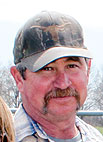
“It behooves us to take good care of our chickens,” explained Jim Shepherd alongside wife, Sharon.
Jim and Sharon maintain four poultry houses and a Hereford herd outside Aurora, Mo., on S&S Farms. The couple have been raising cattle for 35 years and built the poultry houses 14 years ago. “We built the houses as a pathway for me to quit working an off-the-farm job; I’ve been home almost four years now,” said Jim.
Although, Jim and Sharon are glad to be working together on-the-farm full time a lot of hard work and long hours are spent keeping the farm productive.
The Shepherds raise broilers in 4 40×400’ houses for George’s Inc. They raise between 92,000-93,000 chicks per flock for approximately 34-35 days. The target weight is 3.70-3.90 pounds. Their last flock averaged 4.05 pounds.
A crew from George’s comes to the farm a few days prior to catching the birds to take a weight sampling. They calculate how much the birds are gaining per day, allowing them to estimate a date to catch the birds. The houses sit empty for 10-14 days and according to the Shepherds, the houses get to rest but they do not as they must begin preparation for the next flock.
Jim and Sharon keep a close eye on their flock and houses to ensure that they are productive and efficient. During their daily routine, Jim and Sharon have to monitor ventilation, temperature, waterers and feeders making adjustments accordingly and fix malfunctions.
“There is a lot of work involved,” Sharon said as she explained the magnitude of their daily tasks.
S&S Farms just installed a new computer system in each house. The computers control the temperature and fans. “The computers take some of the guess work out of it for us,” said Sharon.
“The computers are more precise,” added Jim. “The temperature is programmed to drop continuously at a slow rate. Before we had to manually adjust the temperature. The birds will tell you what they want and we still make adjustments according to their actions.”
The biggest cost in poultry production is gas and electricity. The Shepherds work hard to control input costs to increase profits. Other costs include maintenance and repair. “Poultry production is the same as any other farming operation except we go through an integrator,” explained Jim.
To supplement their annual income the Shepherds’ planted 22 acres of miscanthus in 2012 with help from MFA Oil Biomass and the Biomass Crop Assistance Program. Through the program MFA Oil Biomass, on a contract base, provides the plants. It was Jim and Sharon’s responsibility to prepare the ground. Once harvested MFA Oil Biomass will purchase the bales.
Over the years the Shepherds have seen an increased disconnect between farmers and consumers. “The general public misses the concept that farmers grow food, it doesn’t just appear in the grocery store. We, as an industry, do a poor job of explaining what it is we do. We need to educate the public,” Jim emphasized.
The Shepherds have heard a lot of misconceptions when it comes to farming and the poultry industry. One misconception that should be addressed is steroids. “I’ve been in the poultry industry all of my life and I’ve never seen steroids fed to poultry. It’s genetics, good management and good advice from Jerry, our George’s representative, that keeps the birds growing. We need to present the facts to the consumer,” said Jim. Focusing on genetics, good management and following Jerry’s advice is exactly what the Shepherds do.
Jim and Sharon operate the farm themselves but their grown children still have an interest in farming. Jay Shepherd and wife, Crystal, and children Cade, 11, and Camryn, 2, along with Terry Shepherd and wife, Megan, come back to the farm whenever possible. The children and grandchildren are the fourth and fifth generations on the farm. Both of their sons are ag teachers and grandson, Cade, shows cattle, pigs and chickens, keeping the family farming heritage alive.
Jim concluded, “We are not a factory farm, we are a family farm.”







